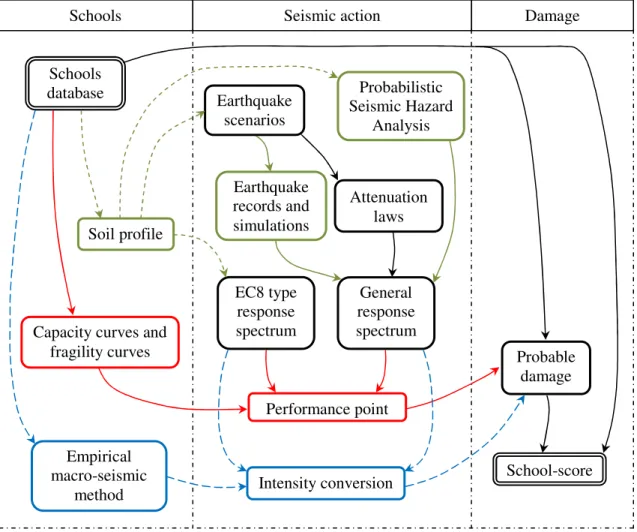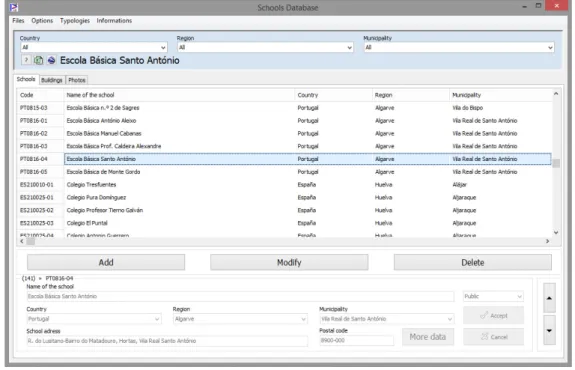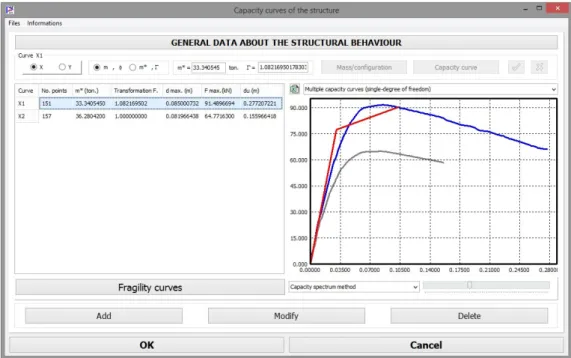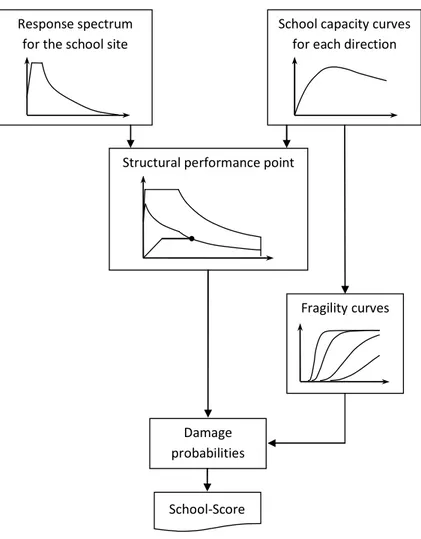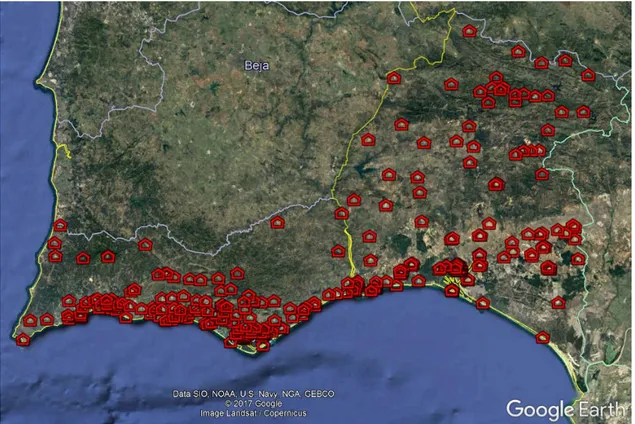EARTHQUAKE RESILIENT
João M.C. ESTÊVÃO1, Mónica A. FERREIRA MARTÍNEZ-ÁLVAREZ4, Luis FAZENDEIRO
Luisa SEGOVIA
Earthquake hazard is present in the
Spain), going beyond borders. Earthquakes cau
vital role in increasing the seismic resilience. This can be
structural vulnerability launching retrofitting programs and (ii) by increasing the
student population in dealing with the phenomenon before, during and after the event. A project named de Escolas Resilientes aos SISmos no Território do Algarve e de Huelva,
development of diagnostic tools, evaluation, management and rehabilitation of primary schools in both regions. Preparing support material for teachers is also intended. All these aims are developed in compliance with the National Civil Protection Policies of
Agreements for disaster risk reduction. PERSI
hierarchy system for the vulnerability of primary schools (school both countries to evaluate the school
implementation in two pilot schools; and developing educational material and a practical guide to support the education and communication of risk to the school population. The
score is presented in this paper. Keywords: Schools Vulnerability; R
1. INTRODUCTION
A project for the seismic study of the primary schools of
It has been named Projetos de Escolas Resilientes aos SISmos no Território do Algarve e de Huelva in Portuguese (hereinafter, PERSISTAH
institutions of both Portugal and Spain. The following ideas support PERSISTAH:
1Professor, Department of Civil Engineering, ISE 2Dr, UAlg / Faro, CEris / Lisbon, Portugal
3Professor, Department of Building Structures and Geotechnical Spain, ame@us.es
4Professor, Department of Computer Science
fmaralv@upo.es
5Researcher, Emergency Planning National Department, Portuguese National Authority for Civil Protection, Carnaxide, Portugal, luis.sa@prociv.pt
6Researcher, Department of Building Structures and Geotechnical Engineering Spain, mrequena1@us.es
7Researcher, Department of Building Structures and Geotechnical Engineering Spain, marisasegovia@us.es
8Professor, IST, Instituto Superior Técnico Lisbon, Portugal, csoliv@civil.ist.utl.pt
EARTHQUAKE RESILIENT SCHOOLS IN ALGARVE (
AND HUELVA (SPAIN)
nica A. FERREIRA2, Antonio MORALES-ESTEBAN , Luis FAZENDEIRO-SÁ5, Victoria REQUENA-GARCÍA
SEGOVIA-VERJEL7, Carlos S. OLIVEIRA8
ABSTRACT
Earthquake hazard is present in the south-western Iberian Peninsula (southern Portugal and
, going beyond borders. Earthquakes cause important impacts in children. Consequently, schools play a seismic resilience. This can be regarded in two manners: (i) by decreasing the structural vulnerability launching retrofitting programs and (ii) by increasing the awareness and
student population in dealing with the phenomenon before, during and after the event. A project named de Escolas Resilientes aos SISmos no Território do Algarve e de Huelva, in Portuguese (PERSISTAH
tic tools, evaluation, management and rehabilitation of primary schools in both regions. Preparing support material for teachers is also intended. All these aims are developed in compliance with the National Civil Protection Policies of both Portugal and Spain. Both countries have signed the Hyogo and Sendai Agreements for disaster risk reduction. PERSISTAH proposes accomplishing the following task
hierarchy system for the vulnerability of primary schools (school-score); forming mixed teams wit
both countries to evaluate the school buildings; developing recommendations for rehabilitation with practical implementation in two pilot schools; and developing educational material and a practical guide to support the cation of risk to the school population. The general methodology to generate the school
isk Communication; Computer Tool; School-Score; E
study of the primary schools of the Algarve and Huelva is being developed. Projetos de Escolas Resilientes aos SISmos no Território do Algarve e de Huelva
, PERSISTAH). It is being carried out collaboratively by universities and institutions of both Portugal and Spain.
The following ideas support PERSISTAH:
Department of Civil Engineering, ISE, University of Algarve, Faro, Portugal, jestevao@ualg.pt
/ Lisbon, Portugal, monicaf@civil.ist.utl.pt
Department of Building Structures and Geotechnical Engineering, University of Seville Department of Computer Science, Pablo de Olavide University of Seville
r, Emergency Planning National Department, Portuguese National Authority for Civil Protection,
luis.sa@prociv.pt
Researcher, Department of Building Structures and Geotechnical Engineering, University of Seville Department of Building Structures and Geotechnical Engineering, University of Seville
stituto Superior Técnico, Dept of Civil Engineering, Architecture and Georesources, CEris,
csoliv@civil.ist.utl.pt
SCHOOLS IN ALGARVE (PORTUGAL)
ESTEBAN3, Francisco GARCÍA-CRUZ6, M.
southern Portugal and south-western onsequently, schools play a in two manners: (i) by decreasing the awareness and capacity of the student population in dealing with the phenomenon before, during and after the event. A project named Projetos (PERSISTAH) aims the tic tools, evaluation, management and rehabilitation of primary schools in both regions. Preparing support material for teachers is also intended. All these aims are developed in compliance with the Both countries have signed the Hyogo and Sendai TAH proposes accomplishing the following tasks: creating a score); forming mixed teams with experts from ; developing recommendations for rehabilitation with practical implementation in two pilot schools; and developing educational material and a practical guide to support the methodology to generate the
school-Earthquake Resilience
Algarve and Huelva is being developed. Projetos de Escolas Resilientes aos SISmos no Território do Algarve e de Huelva, d out collaboratively by universities and
jestevao@ualg.pt University of Seville, Seville, Pablo de Olavide University of Seville, Seville, Spain, r, Emergency Planning National Department, Portuguese National Authority for Civil Protection, University of Seville, Seville, University of Seville, Seville, and Georesources, CEris,
2
- The singularities of the seismicity of this geographic area.
- The interest on the typology of primary schools and the determination of its vulnerability. - The generation of a rehabilitation methodology with practical implementation in two pilot
schools (Algarve and Huelva).
- The communication of the seismic risk to the school population. - The international cooperation for risk reduction.
Regarding the seismicity of this area, it is interesting to note that this area is characterized by the presence of large faults (such as the Azores-Gibraltar fault) that produce large and very large earthquakes with long return periods. These long periods make the population unaware of the risk. Moreover, soft soils are common. In this context, a model to update the seismic hazard of Algarve and Huelva is being developed.
The project will identify the main typologies of primary schools. Then, a detailed inventory of constructive and structural characteristics will be made. Later, the vulnerability curves of each typology will be obtained. A rank (school-score) of seismic school behaviour, based on the hazard, vulnerability and exposure, will be settled. Finally, retrofit will be recommended for those schools not reaching a certain level of safety.
Educational material for both the children and the teaching staff will be done. This is a key action that will try to increase the awareness of the population for the seismic risk.
Finally, under the spirit of Hyogo and Sendai Agreements, there is an added value resulting from the international cooperation for risk reduction. This will be reached by comparing codes of practice, construction techniques, civil protection policies and strategies for seismic risk mitigation in the two regions.
The goal of this manuscript is to present and to develop the concept of school-score. The rest of the paper is structured as follows. Section 2 introduces the methodology proposed to achieve the project goals. Preliminary results are reported in Section 3, which are later discussed in Section 4. Finally, the main conclusions drawn are summarized in Section 5.
2. METHODOLOGY
There are many seismic vulnerability assessment methodologies proposed by different researchers. These can be divided in three major groups: empirical, analytical/mechanical and hybrid (Calvi et al. 2006). In this project, an empirical and an analytical/mechanical approach have been selected to obtain a probable damage for each school. Figure 1 shows the flowchart of the developed methodology. These two approaches – the empirical and analytical/mechanical – are marked in Figure 1 with red and blue lines, respectively. Both are the critical paths to produce results. On the one hand, the blue path is intended to analyse groups of school buildings. On the other hand, the red path is to be applied to individual buildings and it is more accurate. The green colour corresponds to options which will increase the level of accuracy in the results. The black colour represents the input and the output. Two different types of response spectra are used to compute the damage for each school site. The first one is a code-based response spectrum, which depends on the region where the school belongs. The second one is a general response spectrum, namely resulting from an earthquake scenario.
2.1 Seismic Hazard Analysis
The seismic action used to assess the school damage should be selected in accordance with the seismic hazard analysis of the region studied. The present seismicity of Algarve and Huelva can be classified as low-to-moderate (Morales-Esteban et al. 2012) (Figure 2). However, there are many historical earthquakes with marine epicenter that caused much destruction in those regions (Rodríguez 1932). The 1755 earthquake is the main example of a seismic event that caused massive destruction in the southwestern Iberian Peninsula, especially in Algarve (Chester and Chester 2010).
Three different parallel paths are considered for obtaining the seismic action in the PERSISTAH project: a code-based seismic action, an earthquake scenario and the result of a probabilistic seismic hazard analysis.
3
Figure 1. Flowchart for the assessment of the school-score.
Figure 2. Instrumental seismicity catalogue from 1961 to 2016 (IPMA-Portugal)
For the first case, the probable seismic action has been computed from the NP EN 1998-1:2010 code (IPQ 2010), whereas for Huelva the NCSR-02 code (NCSR-02 2002) has been used. The approach dealing with a code-based response spectrum is used having in mind the seismic retrofitting program
Soil profile Earthquake records and simulations Earthquake scenarios Intensity conversion Probable damage Attenuation laws Performance point Capacity curves and
fragility curves Empirical macro-seismic method Schools database
Schools Seismic action Damage
EC8 type response spectrum General response spectrum School-score Probabilistic Seismic Hazard Analysis M≥8 7≤M<8 3≤M<4 4≤M<5 5≤M<6 M<3 6≤M<7
4 of the two schools.
For the case of an earthquake scenario, the response spectrum can be obtained from an attenuation law, recorded accelerogram, or simulated earthquake.
Finally, the seismic action assessment can be carried out for a given return period, through a fully probabilistic seismic hazard analysis.
Site effects have a major influence on the seismic action. So, whenever the soil profile of a school is known, the site amplification will be considered.
2.2 Vulnerability Assessment
Dedicated software has been developed to manage the schools seismic safety. It consists of three different integrated modules: (i) the schools database module, (ii) the seismic actions module, and (iii) the probable damage assessment module.
A visual screening form has been developed and implemented in the first module. It manages the information about the schools (Figure 3). It contains parameters such as the general school identification and a very complete characterization of all constructive-structural independent units obtained after school inspections. All the compiled data are geo-referenced and can be exported to external software, like Excel spreadsheets or the Google Earth, for example.
Figure 3. Example of the software developed for the schools database management.
Two different paths (the blue and the red one, shown in Figure 1) are used in the project to compute the damage. Five damage states are considered in this study.
The blue path approach (Figure 1) for damage assessment uses the empirical macro-seismic method (Lagomarsino and Giovinazzi 2006). This method was already used to assess the damage in the Algarve region (Fazendeiro-Sá et al. 2016; Maio et al. 2016).
The red path corresponds to an analytical/mechanical method in which the first step is to obtain the schools capacity curves (Figure 4).
Two options are considered in the developed software to compute these curves. For the first option of the red path (which is the preferred one as it is more accurate), the values are determined for each individual school through a pushover nonlinear analysis according to the EN 1998-1:2004 (EC8) rules (CEN 2004).
For the second option, to be considered when no individual structural analysis has been carried out for a particular school, a simplified typological capacity curve is used to compute the damage and the
5
school-score. The typological capacity curve is the mean capacity curve of a set of school buildings belonging to the same typology. This is randomly generated following the probability distribution of a set of random variables (for example, the columns cross-section dimensions, the mean span length, the wall thickness and length, or the number of wall openings).
Figure 4. Example of a set of capacity curves obtained for an individual school building (using a “uniform” load pattern and a “modal” load pattern, as proposed in the EC8).
The structural performance point for each school is computed according to the N2 Method (Fajfar 2000), using the iterative procedure proposed in the Annex B of the EC8, when a code-based response spectrum is used, or according to the Capacity Spectrum Method (ATC 1996), when an earthquake scenario is considered. Those routines were previously tested with success to evaluate the structural performance of buildings in Algarve (Estêvão 2016) and in Azores (Estêvão and Carvalho 2015; Maio et al. 2017), which are two Portuguese earthquake-prone regions.
Based on the fragility curves of each individual school building, which are computed using the previously obtained capacity curves, and on the structural performance point, the probabilities of the school damage reaching different given levels are determined (Figure 5-6).
Figure 5. Example of fragility curves managed by the developed software.
6
Figure 6. Flowchart of the analytical/mechanical methodology adopted.
Finally, the school-score is computed. It depends on the probable structural damage level, as well as on other different parameters such as the non-structural vulnerability, the total number of students, the number of possible casualties and the accessibility of the emergency rescue. A multi-criteria scheme is being developed to permit the assignment of weights to each one of these parameters.
High school-score values indicate that the school is less resilient to earthquakes. The school-score will establish a hierarchy list for future interventions, which may include structural retrofitting measures.
2.3 School Seismic Retrofitting
In the past, many countries have adopted ambitious programs aiming to increase the earthquakes schools resilience. This has been the cases of Japan (World Bank 2016) and Venezuela (López et al. 2008; López et al. 2012).
To do so, a biographical review on structural, foundations and constructive rehabilitation techniques will be done. Then, a specific catalogue for primary schools of Algarve and Huelva with new or adapted solutions will be created. Finally, the rehabilitation methodology will be tested in the two schools with worst school-score. This will be used to check the reinforcement techniques and to optimize them.
2.4 Education and Risk Communication
Children play a vital role in society as they are critical to our future. It is well known the psychological impact of an earthquake in children, so communicating risk to young children can be challenging
School capacity curves for each direction
Structural performance point
School-Score Response spectrum
for the school site
Fragility curves
Damage probabilities
7
(Johnson and Ronan 2014). Therefore, in earthquake prone regions, it is very important to make them aware of and prepared for the seismic risk.
In Portugal, in the framework of the European projects (ECHO programme) some earthquake education and preparedness materials have been developed and will be used in the PERSISTAH project, for both the students and educators. Preparedness materials include engaging activities (ready-to-use, hands-on activities) and easy action steps that students will find both fun and effective. This will be a Printable Activity Book targeted to educators that are not sure how to teach about earthquake science and safety.
The following activities will be accomplished. The booklet starts with knowledge about origin of earthquakes, tectonic plates, specific scientific terms, scales of magnitude and intensity. Students can work with a map that divides Portugal and Spain into seismic zones. They can color the zones ranging from Major risk to No risk.
The video game, Treme-Treme® (available at www.treme-treme.pt), will be available at the PERSISTAH website to educate, train and communicate earthquake risk to players/pupils (7-9 yrs.) (Ferreira et al. 2016). Another activity will be an “Earthquake Hazard Hunt” where children can pin-point hazards at home and school and then identify what can be done to mitigate the hazard.
If the activities are engaged properly, students will learn tips and tricks about how to prepare for an earthquake while at school or at home. Children can share their new awareness into posters or videos for the classroom or school. Finally, the PERSISTAH project can also promote and award a drawing competition for children of primary schools.
In this action, planning and earthquake drills will be included in order to prepare children to behave properly in case of disaster. Second, a series of recommendations to update the acting plans will be done. Finally, an informative online portal to be visited by educators, students and the public in general will be created with all the printable educational activities and worksheets. It will include a section dedicated to the seismic risk of each type of school building.
2.5 Cross Border Cooperation
The United Nations (UN) promoted the International Strategy for Disaster Reduction (ISDR) in 2000 to make a safer World in the 21st Century. The UN encourages the establishment of multi-stakeholder coordination mechanisms which include National Platforms for Disaster Risk Reduction. Both countries signed the Hyogo 2005-2015 (United Nations 2007) and Sendai (2015-2030) agreements (United Nations 2015). These agreements are based on the idea of reducing risk disaster cooperatively. A coordinated mechanism among countries allows highlighting the relevance, improving the research efficiency (Weichselgartner and Pigeon 2015) and a better cost-benefit for disaster risk reduction. PERSISTAH is funded by the Interreg-Poctep program via European Regional Development Fund. Interreg differs from the majority of Cohesion Policy programmes in one important respect: it involves a collaboration among authorities of two or more Member States, in this case Portugal and Spain. Interreg measures are not only required to demonstrate a positive impact on the development on either side of the border but their design and, possibly, their implementation must be carried out on a common cross-border basis (EuropeanComission 2017). Interreg is designed to stimulate cooperation between member states of the European Union on different levels. One of its main targets is to diminish the influence of national borders in favour of equal economic, social and cultural development of the whole territory of the European Union. The PERSISTAH project brings an opportunity to study the seismic risk in a cross border framework. One common problem is that neighbouring countries have different catalogues, codes, seismic zonings, etc. (Martínez-Álvarez et al. 2015), which is against the continuity existing through country borders. In this sense, cooperation between countries is essential to deal with this problem. An earthquake catalogue for the whole Iberian Peninsula and adjacent areas was compiled by Amaro-Mellado et al. (2017). Regarding the seismic code, in PERSISTAH, both the NP EN 1998-1:2010 (IPQ 2010) and the NCSR-02 (2002) codes have been implemented.
The PERSISTAH web portal is also going to be a multi-lingual platform where all the project results will be presented in three languages for the international community (Figure 7).
8
Figure 7. Interface for language selection (Portuguese, Spanish and English).
3. PRELIMINARY RESULTS
The analysis of the seismicity of the zone has shown that its seismicity is low-to-moderate. Nevertheless, large and very large earthquakes with long return periods affect this area making the population unaware of the existing seismic hazard.
A total of 142 primary schools have been identified in Algarve (with more than 300 buildings/structural independent units). In Huelva, 139 schools comprehending more than 250 buildings have been catalogued. It can be observed that most schools are located in the coastal in Algarve. Contrariwise, in Huelva schools are spread over the region (Figure 8).
Three major typologies of primary schools have been identified in Algarve. The Plano dos Centenários (Centennial Plan) typology is one of the most common typology in the region (Figure 9). This school typology was set to be built in Algarve by the National Decree of 1941 and ended in the 60's (Ribeiro 2016), and is divided in several sub-typologies according to the phase of the plan development process (phase 1, 2 or 3), school localization (rural or urban) and the number of classrooms (1, 2, 4 or 8 classrooms). In general, the vertical structural system of these buildings is unreinforced masonry. Another identified typology is the P3 School (with a reinforced concrete frame structure), being the Quarteira school the first of this kind in Algarve, which started to work in 1974/75 (Ribeiro 2016), after the Portuguese revolution. Another major typology is related to reinforced concrete school buildings that were built after the beginning of the 90's of the 20th Century, until now.
In Huelva, the following typologies have been identified: linear, compact, intersecting, juxtaposition, sports and prism. The typologies have been divided into the following sub-typologies: linear (L-shape, small straight, medium straight, large straight, and various), compact (without yard, H-shape, compact, with yard, symmetrical), intersecting (volume, irregular, fusion, E-shape, multiple, nexus, swastika), juxtaposition, sports and prism (with/without annex). It has also been observed that most primary schools in Huelva were built in the 80's and most of them are minor to 1000 m2. Regarding the vertical structural system most of them are made of load bearing walls or reinforced concrete. In the horizontal system reinforced concrete slabs are predominant. The soil profile shows the presence of soft soils, specifically, in the marshland of Huelva.
A dedicated software is being developed that will obtain the school-score of all the primary schools of Algarve and Huelva.
9
Figure 8. Location of schools under study.
Figure 9. Example of common typologies in (a) Algarve and (b) Huelva.
a)
10 4. DISCUSSION AND CONCLUSIONS
The visual screening will be used as input for the software that will obtain the school-score according to the methodology proposed in this paper. The visual screening compiles detailed constructive and structural information of all the schools. The software has the advantage of being able to use similar typologies to infer the school-score of other typo-like schools.
There is need of a further knowledge transfer about seismic risk and risk mitigation from specialists and authorities to the citizens, educators and schoolchildren. PERSISTAH will provide teaching notes, a set of presentation slides, handouts, and worksheets designed for students in primary school. The retrofit program of two schools will be of great help in dissemination of seismic risk mitigation. The school-score is an easy-to-use tool to classify the buildings according to their seismic vulnerability. This will be used to prioritize the existing primary school buildings for retrofitting programs.
5. ACKNOWLEDGMENTS
The authors want to thank the INTERREG-POCTEP España-Portugal program and the European Regional Development Fund through the 0313_PERSISTAH_5_P project.
6. REFERENCES
Amaro-Mellado JL, Morales-Esteban A, Asencio-Cortés G, Martínez-Álvarez F (2017). Comparing seismic parameters for different source zone models in the Iberian Peninsula. Tectonophysics, 717 (Supplement C): 449-472.
ATC (1996). Seismic evaluation and retrofit of concrete buildings, Volume 1. Applied Technology Council, Redwood City, California.
Calvi GM, Pinho R, Magenes G, Bommer JJ, Restrepo-Vélez LF, Crowley H (2006). Development of seismic vulnerability assessment methodologies over the past 30 years. ISET Journal of Earthquake Technology, 43 (3): 75-104, Paper No. 472.
CEN (2004). Eurocode 8, Design of Structures for Earthquake Resistance-Part 1: general rules, seismic actions and rules for buildings. EN 1998-1:2004. Comité Européen de Normalisation.
Chester DK, Chester OK (2010). The impact of eighteenth century earthquakes on the Algarve region, southern Portugal. The Geographical Journal, 176 (4): 350–370.
Estêvão JMC. (2016). Utilização do programa EC8spec na avaliação e reforço sísmico de edifícios do Algarve (in Portuguese). 10º Congresso Nacional de Sismologia e Engenharia Sísmica.1-11, CD25, Ponta Delgada, Açores.
Estêvão JMC, Carvalho A (2015). The role of source and site effects on structural failures due to Azores earthquakes. Engineering Failure Analysis, 56: 429-440.
EuropeanComission (2017). Retrieved December 01, 2017, from
http://ec.europa.eu/regional_policy/en/atlas/programmes/2014-2020/europe/2014tc16rfcb005
Fajfar P (2000). A nonlinear analysis method for performance-based seismic design. Earthquake Spectra, 16 (3): 573-592.
Fazendeiro-Sá L, Morales-Esteban A, Neyra PD (2016). A Seismic Risk Simulator for Iberia. Bulletin of the Seismological Society of America, 106 (3): 1198-1209.
Ferreira MA, Barreto P, Oliveira CS, Santos PA, Prada R, O’Neill H. (2016). Treme-Treme®an educational game. 35th General Assembly of the European Seismological Commission - ESC2016-539, Trieste.
11
IPQ (2010). NP EN 1998-1. Eurocódigo 8: Projecto de estruturas para resistência aos sismos. Parte 1: Regras gerais, acções sísmicas e regras para edifícios (in Portuguese). Instituto Português da Qualidade, Caparica, Portugal.
Johnson VA, Ronan KR (2014). Classroom responses of New Zealand school teachers following the 2011 Christchurch earthquake. Natural Hazards, 72 (2): 1075-1092.
Lagomarsino S, Giovinazzi S (2006). Macroseismic and mechanical models for the vulnerability and damage assessment of current buildings. Bulletin of Earthquake Engineering, 4 (4): 415-443.
López OA, Hernández JJ, Marinilli Á, Bonilla R, Fernández N, Domínguez J, Baloa T, Coronel G, Safina S, Vielma R. (2008). Seismic evaluation and retrofit of school buildings in Venezuela. The 14th World Conference on Earthquake Engineering, Beijing, China.
López OA, Marinilli A, Coronel G, Bonilla R, Domínguez J, Vielma R. (2012). Improving seismic safety in Venezuelan schools. The 15th World Conference on Earthquake Engineering, Lisbon, Portugal.
Maio R, Estêvão JMC, Ferreira TM, Vicente R (2017). The seismic performance of stone masonry buildings in Faial island and the relevance of implementing effective seismic strengthening policies. Engineering Structures, 141: 41-58.
Maio R, Ferreira TM, Vicente R, Estêvão J (2016). Seismic vulnerability assessment of historical urban centres: case study of the old city centre of Faro, Portugal. Journal of Risk Research, 19 (5): 551-580.
Martínez-Álvarez F, Gutiérrez-Avilés D, Morales-Esteban A, Reyes J, Amaro-Mellado J, Rubio-Escudero C (2015). A Novel Method for Seismogenic Zoning Based on Triclustering: Application to the Iberian Peninsula. Entropy, 17 (7): 5000.
Morales-Esteban A, de Justo JL, Martínez-Álvarez F, Azañón JM (2012). Probabilistic method to select calculation accelerograms based on uniform seismic hazard acceleration response spectra. Soil Dynamics and Earthquake Engineering, 43 (Supplement C): 174-185.
NCSR-02 (2002). Norma de construcción sismorresistente: parte general y edificación (Real Decreto 997/2002 (in Spanish).
Ribeiro V (2016) As escolas primárias dos Centenários: Subsídios para uma história das construções escolares no Algarve (in Portuguese). In: Algarve C-F-Ud (ed) Apontamentos para a história das culturas de escrita : da idade do ferro à era digital. Faro, pp 289-311.
Rodríguez JG (1932). Catálogo sísmico de la zona comprendida entre los meridianos 5ºE y 20ºW de Greenwich y los paralelos 45º y 25ºN (in Spanish). Dirección General del Instituto Geográfico, Cadastral y de Estadística, Madrid.
United Nations U (2007). International Strategy for Disaster Reduction Hyogo Framework for Action 2005-2015: Building the Resilience of Nations. 1st ed ed., Geneva, Switzerland.
United Nations U (2015). Sendai framework for disaster risk reduction 2015-2030. Third UN World Conference on Disaster Risk Reduction. 1st ed ed., Geneva, Switzerland.
Weichselgartner J, Pigeon P (2015). The Role of Knowledge in Disaster Risk Reduction. International Journal of Disaster Risk Science, 6 (2): 107-116.
